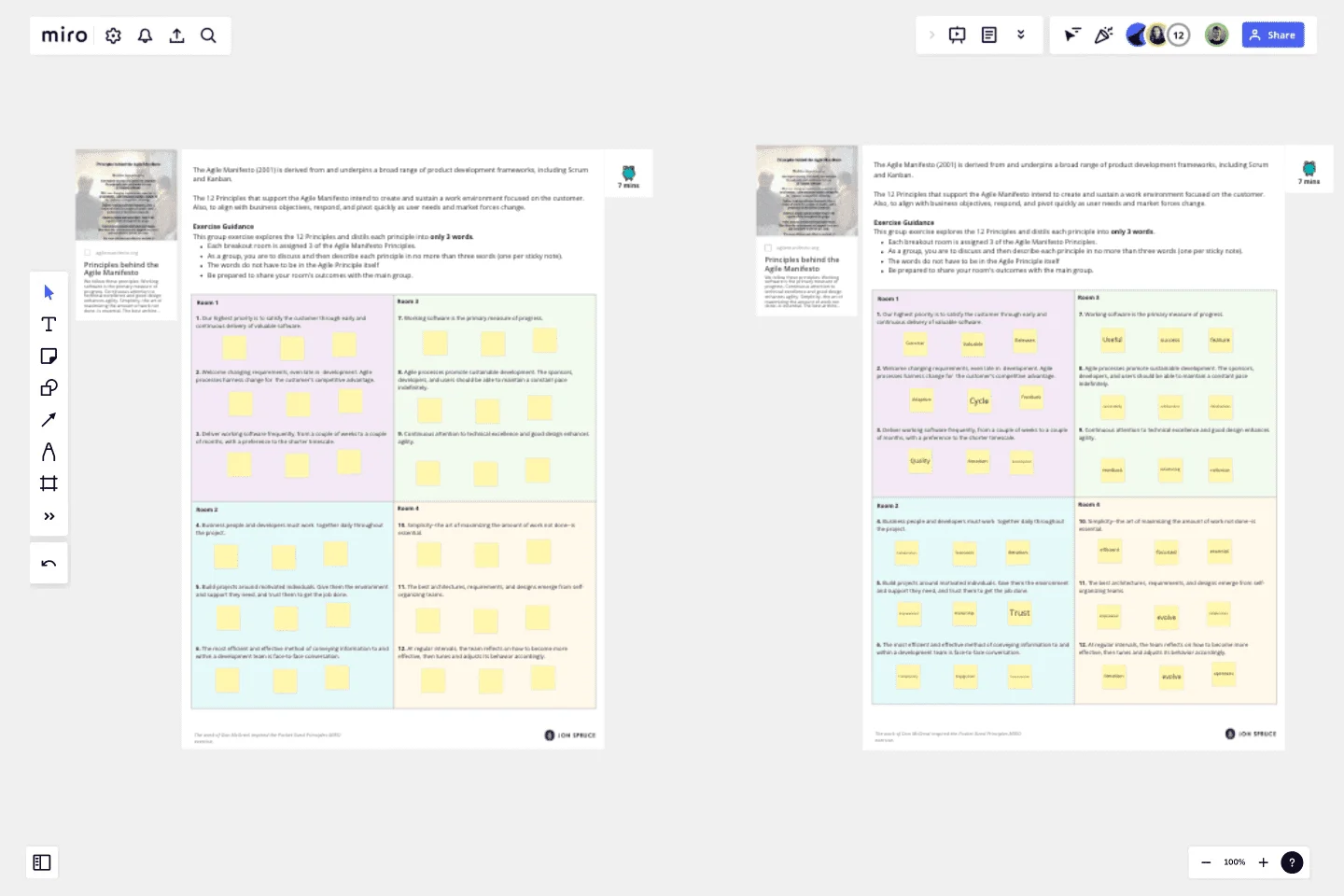The Agile Manifesto - Pocket Sized Principles
Embrace agile principles with The Agile Manifesto - Pocket Sized Principles template. Reinforce collaboration, adaptability, and customer focus.
The 12 Principles that support the Agile Manifesto intend to create and sustain a work environment focused on the customer. Also, to align with business objectives, respond, and pivot quickly as user needs and market forces change.
The 12 Principles of the Agile Manifesto
Satisfying customers through early and continuous delivery of valuable work.
Breaking big work down into smaller tasks that can be completed quickly.
Recognizing that the best work emerges from self-organized teams.
Providing motivated individuals with the environment and support they need and trusting them to get the job done.
Creating processes that promote sustainable efforts.
Maintaining a constant pace for completed work.
Welcoming changing requirements, even late in a project.
Assembling the project team and business owners on a daily basis throughout the project.
Having the team reflect at regular intervals on how to become more effective, then tuning and adjusting behavior accordingly.
Measuring progress by the amount of completed work.
Continually seeking excellence.
Harnessing change for a competitive advantage.
Exercise Guidance
This group exercise explores the 12 Principles and distils each principle into only 3 words.
Each breakout room is assigned 3 of the Agile Manifesto Principles.
As a group, you are to discuss and then describe each principle in upto (but no more than) three words.
Each word should be on a separate sticky note.
The words do not have to be in the Agile Principle itself
Be prepared to share your room's outcomes with the main group.
The most valuable part is their discussion when coming up with the words, as they will all need to understand the principle before describing it.
The Pocket Sized Principles MIRO exercise was inspired by the work of Don McGreal.
This template was created by Jon Spruce.
Get started with this template right now.
Kanban Calendar
Works best for:
Kanban Boards, Agile Methodology, Agile Workflows
Kanban Calendar template enhances workflow visualization by integrating Kanban principles with time management. It enables teams to plan and track tasks across days, weeks, or months, facilitating efficient resource allocation and timely delivery. With customizable features and intuitive design, this template empowers teams to optimize their workflow and meet project deadlines effectively.
Editorial Calendar Template
Works best for:
Marketing, Strategic Planning, Project Planning
If your company is like most, content is a big thing. You create more of it (and a lot faster) than you create almost anything else. It includes blogs, newsletters, social media posts, ads, and more—and it requires ideating, writing, editing, and publishing. That’s why every content team needs an editorial calendar. The template will let you easily create a calendar that empowers your team to plan strategically, keep things organized (by content type, writer, channel, and delivery date), and finalize/post all content on schedule.
Agile Board Template
Works best for:
Agile Methodology, Meetings, Agile Workflows
Part of the popular Agile framework, an Agile Board is a visual display that allows you to sync on tasks throughout a production cycle. The Agile Board is typically used in the context of Agile development methods like Kanban and Scrum, but anyone can adopt the tool. Used by software developers and project managers, the Agile Board helps manage workload in a flexible, transparent and iterative way. The Agile template provides an easy way to get started with a premade layout of sticky notes customizable for your tasks and team.
Kanban Successful Evolutionary Change
Works best for:
Kanban Boards, Agile Methodology, Agile Workflows
Kanban Successful Evolutionary Change template guides organizations through the process of implementing Kanban methodology for gradual and sustainable workflow improvement. By emphasizing incremental changes and continuous feedback, this template fosters a culture of continuous improvement and adaptability. Teams can visualize their workflow, identify bottlenecks, and implement changes iteratively, leading to improved efficiency and productivity.
Work Breakdown Structure Template
Works best for:
Project Management, Mapping, Workflows
A work breakdown is a project management tool that lays out everything you must accomplish to complete a project. It organizes these tasks into multiple levels and displays each element graphically. Creating a work breakdown is a deliverable-based approach, meaning you’ll end up with a detailed project plan of the deliverables you must create to finish the job. Create a Work Breakdown Structure when you need to deconstruct your team's work into smaller, well-defined elements to make it more manageable.
Action Plan Template
Works best for:
Education, Project Management, Project Planning, Kanban
Why create an action plan? Long-term business strategies and goals are only good if you can make them a reality—by accomplishing every small task along the way. An action plan lists those tasks and lays them out in clear detail. It helps you keep everything in order, make sure nothing is missed, and get stakeholders on the same page to complete a project quickly and effectively. This template will help you write an action plan that’s SMART: Specific, Measurable, Actionable, Realistic, and Time-bound.
